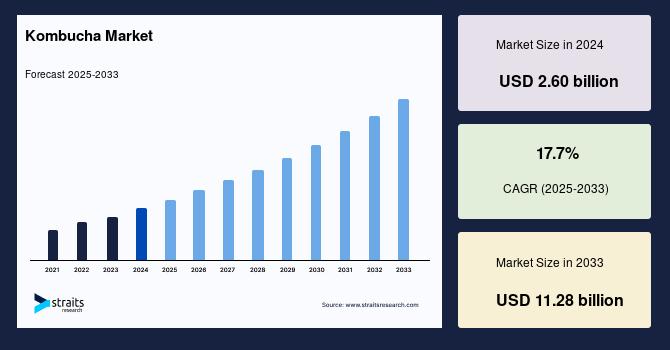Kombucha, a fermented tea drink celebrated for its probiotic potential, effervescence, and wellness appeal, is solidifying its position within the functional beverage sector. As consumers increasingly embrace health-forward drink choices, kombucha has nurtured strong growth paths across all regions. From traditional kombucha to booming hard-variety segments, the market is being shaped by evolving tastes, packaging convenience, and premium positioning.
Market Snapshot & Forecast
The global kombucha market size was valued at USD 2.60 billion in 2024. It is estimated to reach from USD 3.06 billion by 2025 to USD 11.28 billion by 2033, growing at a CAGR of 17.7% during the forecast period (2025–2033).
At a regional level, North America remains the dominant market, accounting for nearly half of the global value (~USD 1.7 billion in 2025), bolstered by wellness trends and wide product availability. Meanwhile, Asia-Pacific outpaces other regions in growth trajectory with annual expansion rates possibly exceeding 24–25% thanks to rising urban incomes and evolving health-conscious consumption.
Kombucha Market Growth Factor
Increasing health consciousness among consumers
The surging trend of health consciousness among consumers is a significant driver for the global kombucha industry. As people become more aware of the benefits of maintaining a healthy lifestyle, there is a rising demand for beverages that offer health benefits beyond basic nutrition. Kombucha, a fermented tea rich in probiotics, antioxidants, and organic acids, is gaining popularity for its potential health benefits, like improved digestion, enhanced immune function, and detoxification.
Product Segmentation
Conventional vs. Hard Kombucha
-
Conventional Kombucha dominates overall sales comprising the vast majority of offerings. Its broad appeal blends flavors like ginger, turmeric, and fruit-driven infusions with perceived gut-beneficial properties.
-
Hard Kombucha, with a modest alcohol content, is the fastest-growing segment especially in North America and Asia-Pacific. Targeting consumers who seek lighter alcoholic alternatives, hard kombucha blends the benefits of fermentation with social drinking culture. This segment is forecast to grow fast, with double-digit annual rates.
Natural vs. Flavored
Flavored kombucha accounts for over 80% of global sales volume driven by variety-seeking consumers enjoying fruit, botanical, and spice combinations. However, growth in traditional, unflavored kombucha is faster, buoyed by a cultural shift toward authenticity and artisanal fermentation methods.
Organic Positioning
Organic kombucha currently holds over 70% of market revenue underscoring consumer preference for clean-label, sustainable options. Organic branding not only resonates with health consciousness but also supports premium pricing and brand loyalty.
Packaging and Sales Channels
Packaging Trends
-
Glass Bottles still dominate (roughly 70–75% of packaging), prized for aesthetic quality, flavor preservation, and premium perception.
-
Aluminum Cans are gaining significance, with near 16% annual growth. They offer portability, recyclability, and align well with on-the-go consumption especially among younger audiences.
Distribution Channels
-
Off‑Trade Retail (supermarkets, specialty stores) accounts for over half of sales. These outlets are key for discovery and impulse purchases.
-
On‑Trade Channels (cafés, bars, restaurants) are growing (~16% annual sales growth), positioning kombucha as a functional, elevated beverage option served alongside meals.
-
E‑Commerce and direct-to-consumer platforms are also rising, offering subscription models and chilled delivery fitting the lifestyle of convenience-focused consumers.
Core Market Drivers
-
Rising Health Awareness: Consumers increasingly seek beverages with functional appeal, aligning with gut health, natural ingredients, and probiotic content.
-
Flavor Innovation: Brand competition, seasonal launches, and unique flavor profiles (e.g., superfoods, botanicals) keep the category fresh and engaging.
-
Convenient Formats: Ready-to-drink packaging, especially in cans, supports active lifestyles, outdoor use, and on-the-go nutrition.
-
Premium Brand Positioning: Artisanal production, organic certifications, and sustainable packaging help brands justify higher prices and retain discerning audiences.
-
Global Expansion: Emerging markets like those in Asia, Latin America, and Africa offer untapped potential as supply chains and awareness grow.
Emerging Trends & Strategic Opportunities
-
Hard Kombucha is rapidly evolving from niche to mainstream, capturing crossover consumers seeking lower-calorie alcoholic beverages.
-
Regional Flavor Adaptation: Localizing Kombucha with regional ingredients such as tropical fruits in APAC or herbs in European lines can foster broader cultural resonance.
-
Eco-Conscious Packaging: Canned Kombucha aligned with circular economy and recyclability initiatives can attract environmentally conscious consumers.
-
Functional Enhancements: Blends with added vitamins, adaptogens, or performance-focused ingredients open doors to wellness and active lifestyle segments.
-
Digital Storytelling & Community Building: Brands utilizing influencer collaborations, storytelling, and DTC platforms can strengthen brand loyalty and product differentiation.
Challenges to Navigate
-
Price Sensitivity: Premium positioning raises cost barriers in lower-income markets balancing affordability with quality is key.
-
Regulatory Compliance: Ingredients, labeling (particularly alcohol-related), and probiotic claims vary by market requiring careful navigation to avoid misrepresentation.
-
Saturation Risk: As competition mounts, brands must differentiate through packaging, flavor innovation, and meaningful brand identity.
Looking Ahead
The kombucha market is more than a health drink trend it’s maturing into a multifaceted category that intersects wellness, social consumption, and lifestyle innovation. With strong growth fundamentals, diversified product offerings, and increasing global reach, kombucha is set to remain a top-tier challenger in the functional beverages arena.
Success hinges on balancing authenticity and creativityblending heritage fermentation with modern marketing, sustainability, and tailored experiences. Brands that master both fermented tradition and delivery innovation will lead the next wave of kombucha growth.



